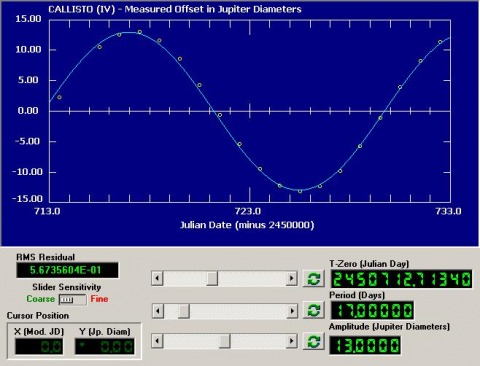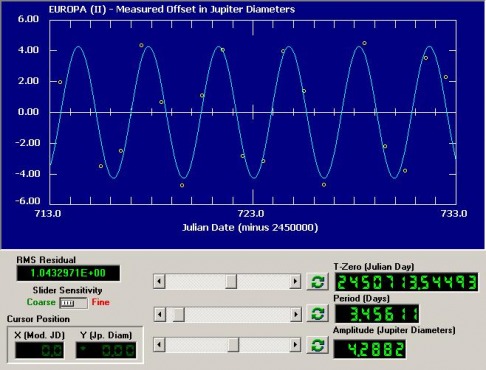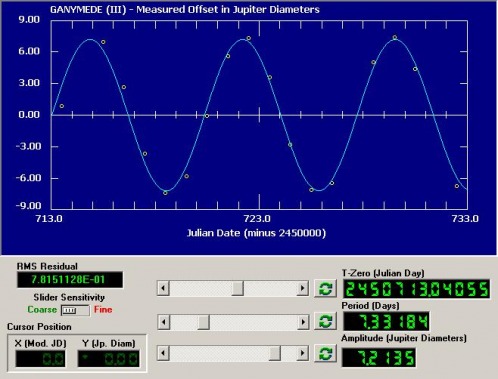Elise Livingston
Kepler's Third Law and the Orbits of the Moons of Jupiter
Purpose
- To determine the mass of Jupiter
- To gain a deeper undewrstanding of Kepler's 3rd law
- Learn how to gather and analyze astronomical data
- To gain a deeper undewrstanding of Kepler's 3rd law
- Learn how to gather and analyze astronomical data
Background
For many centuries scientists have been gazing into the sky and taking meticulous notes to learn more about the celestial bodies in space. How far away are they? How can we measure them? One scientist, Nicholaus Copernicus hypothesized that all of the planets revolve in circular orbits around the sun, and another scientist, Tycho Brahe carefully observed the locations of planets and stars over a period of 20 years. Using Copernicus's hypothesis and Brahe's data, Johannes Kepler derived three mathematical laws regarding the orbiting of one body around another. His third law for a moon orbiting around a much larger body stated that C = r^3 / T^2. (r being radius in AU and T being period in Earth years). Newton took Kepler's law even further and, using his Universal Law of Gravitation, he found that:
Once the telescope was invented, Galileo used it to observe far away planets and stars that could never be seen before. He discovered the the planet Jupiter had four moons that orbited it. This was very important because it served as a miniature version of the entire universe. The Jupiter System was then used to help further scientific knowledge of planetary orbits.
Equipment
For this lab, all that is essentially needed is a computer equipt with CLEA Revolutions of Jupiter software.
Procedure
- http://geddesphysics.weebly.com/moons-of-jupiter.html
Data
r (J.D) r (m) r^3 (m^3) T (days) T (s) T^2 (s^2)
Io 2.76 394680000 6.14802 x 10^25 2.12519 183616.416 3.37149 x 10^10
Europa 4.2882 613212600 2.30586 x 10^26 3.45611 298607.904 8.91666 x 10^10
Ganymede 7.2135 1031530500 1.09761 x 10^27 7.33184 633470.976 4.01285 x 10^11
Callisto 13.00 1859000000 6.42448 x 10^27 17.0000 1468800.0 2.15737 x 10^12
Io 2.76 394680000 6.14802 x 10^25 2.12519 183616.416 3.37149 x 10^10
Europa 4.2882 613212600 2.30586 x 10^26 3.45611 298607.904 8.91666 x 10^10
Ganymede 7.2135 1031530500 1.09761 x 10^27 7.33184 633470.976 4.01285 x 10^11
Callisto 13.00 1859000000 6.42448 x 10^27 17.0000 1468800.0 2.15737 x 10^12
Data Analysis
To analyze the data that was obtained, CLEA software was used to fit sine graphs to the data for each of the four moons.
r^3 vs. T^2 Graph
The r^3 data was plotted on the y-axis and the T^2 data on the x-axis and a best fit line was calculated. The slope of this line was 3.001 x 10^15. This slope was used to calculate the mass of Jupiter:
Once the mass of Jupiter was calculated from the lab, an accepted mass was used in comparison in order to find the percent error:
Conclusion
1. Calculate the percent error with the accepted mass of Jupiter.
The percent error was calculated to be -6.52%.
2. There are moons beyond the orbit of Callisto. Will they have larger or smaller periods than Callisto? Why?
They will have periods that are larger than that of Callisto. Since they are farther away from Jupiter, they will have a much larger orbital path and a slower
velocity, making the time required to make one full orbit much greater.
3. Which do you think would cause the larger error in the mass of Jupiter calculation: a ten percent error in "T" or a ten percent error in "r"? Why?
There would probably be a greater impact on the error calculation in the mass of Jupiter if there was a ten percent error in the "r" value. This is because the "r"
value is used to find the "T" value. If the "r" value was off, all of the "T" data would definitely be thrown off and the percent error would increase dramatically.
4. Why were Galileo's observations of the orbits of Jupiter's moons an important piece of evidence supporting the heliocentric model of the universe?
Jupiter and its moons represent a mini-solar system. By observing how the moons orbit around Jupiter, it was easier to see the characteristics of one body
orbiting around another. Using these characteristics, as well as data from our own planet, scientists could see proof that Earth revolves around the sun,
therefore backing the heliocentric model over the geocentric model.
The percent error was calculated to be -6.52%.
2. There are moons beyond the orbit of Callisto. Will they have larger or smaller periods than Callisto? Why?
They will have periods that are larger than that of Callisto. Since they are farther away from Jupiter, they will have a much larger orbital path and a slower
velocity, making the time required to make one full orbit much greater.
3. Which do you think would cause the larger error in the mass of Jupiter calculation: a ten percent error in "T" or a ten percent error in "r"? Why?
There would probably be a greater impact on the error calculation in the mass of Jupiter if there was a ten percent error in the "r" value. This is because the "r"
value is used to find the "T" value. If the "r" value was off, all of the "T" data would definitely be thrown off and the percent error would increase dramatically.
4. Why were Galileo's observations of the orbits of Jupiter's moons an important piece of evidence supporting the heliocentric model of the universe?
Jupiter and its moons represent a mini-solar system. By observing how the moons orbit around Jupiter, it was easier to see the characteristics of one body
orbiting around another. Using these characteristics, as well as data from our own planet, scientists could see proof that Earth revolves around the sun,
therefore backing the heliocentric model over the geocentric model.








